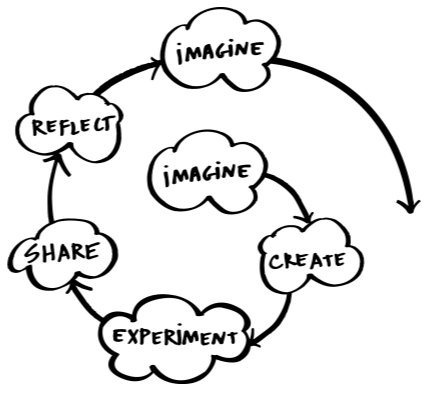Learning with scratch
原文地址:https://llk.media.mit.edu/scratch/Learning-with-Scratch.pdf
翻译:
童鞋们使用Scratch创建互动故事,动画,游戏,音乐,能够学到些什么?
一方面,他们学习数学和计算思想,这些都是建立在Scratch过程中的。当童鞋们在Scratch中创建项目时,他们可以学习到计算核心概念,如迭代和条件语句。他们还可以了解了一些重要的数学概念,如坐标、变量和随机数。
值得注意的是,同学鞋们是在一个有意义和主动的背景下学习这些概念。当同学鞋们在传统的代数课上学习变量时,他们通常对这个概念很难感同身受,但是当他们在Scratch环境中学习变量时,他们可以立即以非常有意义的方式使用变量:控制动画的速度,或者在他们创建的游戏中记录分数。
当同学鞋们做Scratch项目时,他们同时也学习了设计的过程(也可以叫流程或步骤)。通常情况下,学生会从一个创意开始,然后创建一个项目原型,之后对它进行试用,在出现问题时进行调试,从其他人那里得到反馈,然后修改和重新设计它。这是一个持续不断的螺旋研发过程:得到一个想法,创建一个项目,这个项目会带来新的想法,从而产生新的项目,并且一直持续下去。
这个项目设计过程结合了许多21世纪的学习技能,这些技能对童鞋们未来获得成功至关重要:创造性思维、清晰沟通、系统分析、有效协作、迭代设计、持续学习。在Scratch中创建项目也有助于学生使用数字技术来进行深层次的熟练(fluency )的研发。“熟练(fluency )”是什么意思?要想被认为熟练地掌握的英语、西班牙语或其他语言,你不仅要学会阅读,还要学会写,也就是说,能够用这种语言表达自己。同样的,要想熟练掌握数字技术,你不仅要学会如何与计算机进行交互,还要学会如何使用它进行创造。当然,大多数学生长大后不会成为专业程序员,就像大多数学生不会成为职业作家一样。但学习编程对每个人都有好处:它使学生能够更充分和创造性地表达自己,帮助他们发展成为逻辑思考者,并帮助他们明白日常生活中遇到的新技术的工作原理。
原文:
What do young people learn as they create interactive stories, animations, games, music, and art with Scratch?
For one thing, they learn mathematical and computational ideas that are built into the Scratch experience. As students create programs in Scratch, they learn core computational concepts such as iteration and conditionals. They also gain an understanding of important mathematical concepts such as coordinates, variables, and random numbers.
Significantly, students learn these concepts in a meaningful and motivating context. When students learn about variables in traditional algebra classes, they usually feel little personal connection to the concept. But when they learn about variables in the context of Scratch, they can use variables immediately in very meaningful ways: to control the speed of an animation, or to keep track of the score in a game they are creating. As students work on Scratch projects, they also learn about the process of design. Typically, a student will start with an idea, create a working prototype, experiment with it, debug it when things go wrong, get feedback from others, then revise and redesign it. It’s a continuous spiral: get an idea, create a project, which leads to new ideas, which lead to new projects, and on and on.
This project-design process combines many of the 21st century learning skills that will be critical to success in the future: thinking creatively, communicating clearly, analyzing systematically, collaborating effectively, designing iteratively, learning continuously. Creating projects in Scratch also helps students develop a deeper level of fluency with digital technology. What do we mean by fluency? To be considered fluent in English, Spanish, or other language, you must learn not only how to read but also to write – that is, how to express yourself with the language. Similarly, to be fluent with digital technology, you must learn not only how to interact with the computer but also to create with it. Of course, most students will not grow up to become professional programmers, just as most will not become professional writers. But learning to program offers benefits for everyone: it enables students to express themselves more fully and creatively, helps them develop as logical thinkers, and helps them understand the workings of the new technologies that they encounter everywhere in their everyday lives. References Scratch: Programming for All (http://bit.ly/YcK3n) 21st Century Learning Skills (http://bit.ly/119M3wZ)



 浙公网安备 33010602011771号
浙公网安备 33010602011771号